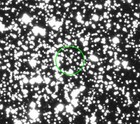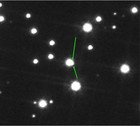

Janusz Kaluzny, Agata Rozanska, Michał Rozyczka, Wojtek Krzeminski and Ian Thompson demonstrated that the brightest X-ray source in the globular cluster M4 is almost certainly a neutron star. The photo on the left shows the central region of M4 as seen from the ground. The location of the optical counterpart of the source is marked on a frame taken by the Hubble Space Telescope (right).
Globular clusters contain a large population of exotic binary stars with degenerate components, many of which are X-ray sources with various degrees of activity. Numerous such sources have been detected by the Chandra space observatory in over 80 clusters, providing a valuable tracer population for large-scale numerical simulations of cluster evolution.
One of those clusters is M4. The brightest X-ray source found in its core region (CX 1) was originally classified as a cataclysmic variable, and identified it with a V = 17.4 object, located on the main sequence of the cluster just below the turnoff.
The HST-photometry of M4 published by Anderson et al. (2008, AJ 503, 325) and other archival HST data show that the optical counterpart of CX 1 is a blend of two stars. Based on HST data, and our own ground-based photometry, we detected stable sinusoidal variations of the flux from the blend, and demonstrated that the source of variability was the fainter and redder component of the pair - a 20th magnitude star, located on the lower main sequence of the cluster.
We found the X-ray flux to be also periodically variable, with X-ray and optical minima coinciding. Stability of the optical light curve, lack of UV-excess, and unrealistic mean density resulting from period-density relation for semidetached systems, speak against the original identification of CX 1 as a cataclysmic variable. We argue that the X-ray active component of this system is a neutron star (probably a millisecond pulsar). If this finding is confirmed, CX 1 will be the second such object found in M4 after the pulsar PSR1620-26.






